Giant oceanic manta ray
The giant oceanic manta ray, giant manta ray, or oceanic manta ray, (Mobula birostris) is a species of ray in the family Mobulidae, and the largest type of ray in the world. It is circumglobal and is typically found in tropical and subtropical waters, but can also be found in temperate waters.[3] Until 2017, the species was classified in the genus Manta, along with the smaller reef manta ray (Mobula alfredi). DNA testing revealed that both species are more closely related to rays of the genus Mobula than previously thought. As a result, the giant manta was renamed as Mobula birostris to reflect the new classification.[4]
| Giant oceanic manta ray | |
|---|---|
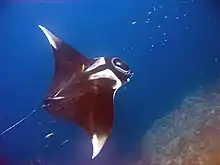 | |
| Scientific classification | |
| Kingdom: | Animalia |
| Phylum: | Chordata |
| Class: | Chondrichthyes |
| Order: | Myliobatiformes |
| Family: | Mobulidae |
| Genus: | Mobula |
| Species: | M. birostris |
| Binomial name | |
| Mobula birostris Walbaum, 1792 | |
 | |
| Range of the giant oceanic manta ray | |
| Synonyms | |
| |
Description

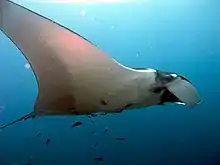
The giant oceanic manta ray can grow to a disc size of up to 7 m (23 ft) across with a weight of about 3,000 kg (6,600 lb)[5][6] but average size commonly observed is 4.5 m (15 ft).[7] It is dorsoventrally flattened and has large, triangular pectoral fins on either side of the disc. At the front, it has a pair of cephalic fins which are forward extensions of the pectoral fins. These can be rolled up in a spiral for swimming or can be flared out to channel water into the large, forward-pointing, rectangular mouth when the animal is feeding. The teeth are in a band of 18 rows and are restricted to the central part of the lower jaw. The eyes and the spiracles are on the side of the head behind the cephalic fins, and the gill slits are on the ventral (under) surface. It has a small dorsal fin and the tail is long and whip-like. The manta ray does not have a spiny tail as do the closely related devil rays (Mobula spp.) but has a knob-like bulge at the base of its tail.[8]
The skin is smooth with a scattering of conical and ridge-shaped tubercles. The colouring of the dorsal (upper) surface is black, dark brown, or steely blue, sometimes with a few pale spots and usually with a pale edge. The ventral surface is white, sometimes with dark spots and blotches. The markings can often be used to recognise individual fish.[9] Mobula birostris is similar in appearance to Mobula alfredi and the two species may be confused as their distribution overlaps. However, there are distinguishing features.
Physical distinctions between oceanic manta ray and reef manta ray
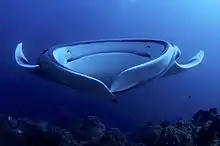
The oceanic manta ray is larger than the reef manta ray, 4 to 5 metres in average against 3 to 3.5 metres.[10] However, if the observed rays are young, their size can easily bring confusion. Only the colour pattern remains an effective way to distinguish them. The reef manta ray has a dark dorsal side with usually two lighter areas on top of the head, looking like a nuanced gradient of its dark dominating back coloration and whitish to greyish, the longitudinal separation between these two lighter areas forms a kind of "Y". While for the oceanic manta ray, the dorsal surface is deep dark and the two white areas are well marked without gradient effect. The line of separation between these two white areas form meanwhile a "T".
Difference can also be made by their ventral coloration, the reef manta ray has a white belly with often spots between the branchial gill slits and other spots spread across trailing edge of pectoral fins and abdominal region. The oceanic manta ray has also a white ventral coloration with spots clustered around lower region of its abdomen. Its cephalic fins, inside of its mouth and its gill slits are often black.
Distribution and habitat
The giant oceanic manta ray has a widespread distribution in tropical and temperate waters worldwide. In the Northern Hemisphere, it has been recorded as far north as southern California and New Jersey in the United States, Aomori Prefecture in Japan, the Sinai Peninsula in Egypt, and the Azores in the northern Atlantic. In the Southern Hemisphere, it occurs as far south as Peru, Uruguay, South Africa, and New Zealand.[11]
It is an ocean-going species and spends most of its life far from land, travelling with the currents and migrating to areas where upwellings of nutrient-rich water increase the availability of zooplankton.[12] The oceanic manta ray is often found in association with offshore oceanic islands.[8]
Captivity

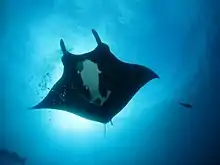
There are few public aquariums with giant manta ray in captivity. For a period Marine Life Park, a part of the Resorts World Sentosa in Singapore, was the only one to maintain this species,[13][14] but since late 2018 it has also been exhibited at Nausicaä Centre National de la Mer in France and Okinawa Churaumi Aquarium in Japan.[15]
Biology
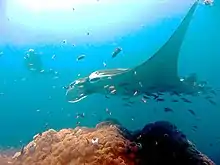
When traveling in deep water, the giant oceanic manta ray swims steadily in a straight line, while further inshore it usually basks or swims idly around. Mantas may travel alone or in groups of up to 50 and sometimes associate with other fish species, as well as sea birds and marine mammals. About 27% of their diet is based on filter feeding, consuming large quantities of zooplankton in the form of shrimp, krill, and planktonic crabs. An individual manta may eat about 13% of its body weight each week. When foraging, it usually swims slowly around its prey, herding the planktonic creatures into a tight group before speeding through the bunched-up organisms with its mouth open wide.[16] While feeding, the cephalic fins are spread to channel the prey into its mouth and the small particles are sifted from the water by the tissue between the gill arches. As many as 50 individual fish may gather at a single, plankton-rich feeding site.[9] Research published in 2016 proved about 73% of their diet is mesopelagic (deep water) sources including fish. Earlier assumptions about exclusively filter feeding were based on surface observations.[17]
The giant oceanic manta ray sometimes visits a cleaning station on a coral reef, where it adopts a near-stationary position for several minutes while cleaner fish consume bits of loose skin and external parasites. Such visits occur most frequently at high tide.[18] It does not rest on the seabed as do many flat fish, as it needs to swim continuously to channel water over its gills for respiration.[19]
Males become sexually mature when their disc width is about 4 m (13 ft), while females need to be about 5 m (16 ft) wide to breed. When a female is becoming receptive, one or several males may swim along behind her in a "train". During copulation, one of the males grips the female's pectoral fin with his teeth and they continue to swim with their ventral surfaces in contact. He inserts his claspers into her cloaca and these form a tube through which the sperm is pumped. The pair remains coupled together for several minutes before going their own way. [20]
The fertilized eggs develop within the female's oviduct. At first, they are enclosed in an egg case and the developing embryos feed on the yolk. After the egg hatches, the pup remains in the oviduct and receives nourishment from a milky secretion.[21] As it does not have a placental connection with its mother, the pup relies on buccal pumping to obtain oxygen.[22] The brood size is usually one but occasionally two embryos develop simultaneously. The gestation period is thought to be 12–13 months. When fully developed, the pup is 1.4 m (4 ft 7 in) in disc width, weighs 9 kg (20 lb) and resembles an adult. It is expelled from the oviduct, usually near the coast, and it remains in a shallow-water environment for a few years while it grows.[9][21]
The oceanic manta has one of the largest brains (ten times larger than a whale shark) and the largest brain-to-mass ratio of any cold blooded fish. It heats the blood going to its brain and is one of the few animals (land or sea) that might pass the mirror test, seemingly exhibiting self-awareness.[23]
Status and threats
Natural predation
Because of its large size and velocity in case of danger (24 km/h escape speed),[24] the oceanic manta ray has very few natural predators that could be fatal to it. Only large sharks and dolphins, such as the tiger shark (Galeocerdo cuvier), the great hammerhead shark (Sphyrna mokarran), the bullshark (Carcharhinus leucas), the false killer whale (Pseudora crassidens), and the killer whale (Orcinus orca), are capable of preying on the ray. Nonlethal shark bites are very common occurrences, with a vast majority of adult individuals bearing the scars of at least one attack.[25]
Fishery
The oceanic manta ray is considered to be endangered by the IUCN’s Red List of Endangered Species because its population has decreased drastically over the last twenty years due to overfishing. Whatever the type of fishing (artisanal, targeted or bycatch), the impact on a population which has a low fecundity rate, a long gestation period with mainly a single pup at a time, and a late sexual maturity can only be seriously detrimental to a species that cannot compensate for the losses over several decades.[26] In recent years, fishing for manta rays has been significantly boosted by the price of their gill rakers on the traditional Chinese Medicine market.[27] In June 2018 the New Zealand Department of Conservation classified the giant oceanic manta ray as "Data Deficient" with the qualifier "Threatened Overseas" under the New Zealand Threat Classification System.[28]
See also
References
- Sepkoski, Jack (2002). "A compendium of fossil marine animal genera (Chondrichthyes entry)". Bulletins of American Paleontology. 364: 560. Archived from the original on 2012-05-10. Retrieved 2008-01-09.
- Marshall, A., Barreto, R., Carlson, J., Fernando, D., Fordham, S., Francis, M.P., Derrick, D., Herman, K., Jabado, R.W., Liu, K.M., Rigby, C.L. & Romanov, E. 2020. Mobula birostris. The IUCN Red List of Threatened Species 2020: e.T198921A68632946.
- "Mantas at a Glance". The Manta Trust. 2011. Archived from the original on 2013-01-03. Retrieved 2012-04-04.
- White, William T; Corrigan, Shannon; Yang, Lei; Henderson, Aaron C; Bazinet, Adam L; Swofford, David L; Naylor, Gavin J P (2018-01-01). "Phylogeny of the manta and devilrays (Chondrichthyes: mobulidae), with an updated taxonomic arrangement for the family". Zoological Journal of the Linnean Society. 182 (1): 50–75. doi:10.1093/zoolinnean/zlx018. ISSN 0024-4082.
- "Giant Manta Ray caught in Batticaloa - Sri Lanka Latest News". Sri Lanka News - Newsfirst. 11 August 2018. Retrieved 9 February 2019.
- McClain, Craig R.; Balk, Meghan A.; Benfield, Mark C.; Branch, Trevor A.; Chen, Catherine; Cosgrove, James; Dove, Alistair D.M.; Gaskins, Leo C.; Helm, Rebecca R. (2015-01-13). "Sizing ocean giants: patterns of intraspecific size variation in marine megafauna". PeerJ. 3: e715. doi:10.7717/peerj.715. ISSN 2167-8359. PMC 4304853. PMID 25649000.
- "Mantas at a Glance". Manta Trust. Archived from the original on 2013-01-03. Retrieved 2016-12-15.
- Stevens, Guy (2011) "Field guide to the identification of Mobulid rays (Mobulidae)" Archived 2016-10-20 at the Wayback Machine. Manta Trust.
- Passarelli, Nancy; Piercy, Andrew. "Biological profiles: Manta birostris". Ichthyology. Florida Museum of Natural History. Retrieved 2013-09-14.
- "Mantas at a Glance | Manta Trust". www.mantatrust.org. Archived from the original on 2013-01-03. Retrieved 2016-07-19.
- Marshall, A., Bennett, M.B., Kodja, G., Hinojosa-Alvarez, S., Galvan-Magana, F., Harding, M., Stevens, G. & Kashiwagi, T. 2018. Mobula birostris (amended version of 2011 assessment). The IUCN Red List of Threatened Species 2018: e.T198921A126669349.
- Luiz Jr, O. J.; Balboni, A. P.; Kodja, G.; Andrade, M.; Marum, H. (2009). "Seasonal occurrences of Manta birostris (Chondrichthyes: Mobulidae) in southeastern Brazil". Ichthyological Research. 56 (1): 96–99. doi:10.1007/s10228-008-0060-3. ISSN 1616-3915.
- Long, Wong Lee. "Singapore Academy of Corporate Management - Singapore Marine Life Park". Retrieved 2018-01-09.
- "Top 5 Things to Do on Sentosa Island". www.marinabaysands.com. Retrieved 2018-01-09.
- "The world's largest ray! The giant manta!". Okinawa Churaumi Aquarium. 2019-01-04. Retrieved 2019-01-05.
- Ebert, D. A. (2003). Sharks, Rays and Chimaeras of California. University of California Press. pp. 230–233. ISBN 0-520-22265-2.
- "Giant rays shown to be predators of the deep". phys.org. Retrieved 9 February 2019.
- Jaine, Fabrice R. A.; Couturier, Lydie I. E.; Weeks, Scarla J.; Townsend, Kathy A.; Bennett, Michael B.; Fiora, Kym; Richardson, Anthony J. (2012). "When giants turn up: sighting trends, environmental influences and habitat use of the manta ray Manta alfredi at a coral reef". PLoS ONE. 7 (10): e46170. doi:10.1371/journal.pone.0046170. PMC 3463571. PMID 23056255.

- Deakos, M. (2010). "Paired-laser photogrammetry as a simple and accurate system for measuring the body size of free-ranging manta rays Manta alfredi". Aquatic Biology. 10: 1–10. doi:10.3354/ab00258.
- Yano, K.; Sato, F.; Takahashi, T. (1999). "Observations of mating behavior of the manta ray, Manta birostris, at the Ogasawara Islands, Japan". Ichthyological Research. 46 (3): 289–296. doi:10.1007/BF02678515.
- Marshall, A. D.; Bennett, M. B. (2010). "Reproductive ecology of the reef manta ray Manta alfredi in southern Mozambique". Journal of Fish Biology. 77 (1): 185–186. doi:10.1111/j.1095-8649.2010.02669.x. PMID 20646146.
- Tomita, T.; Toda, M.; Ueda, K.; Uchida, S.; Nakaya, K. (2012). "Live-bearing manta ray: how the embryo acquires oxygen without placenta and umbilical cord". Biology Letters. 8 (5): 721–724. doi:10.1098/rsbl.2012.0288. PMC 3440971. PMID 22675137.
- McDermott, Amy. "Manta ray brainpower blows other fish out of the water". Oceana. Retrieved 9 February 2019.
- "Natural Predation". Manta Trust. Archived from the original on 2015-07-11. Retrieved 2016-12-15.
- Marshall, A D; Bennett, M B (2010). "The frequency and effect of shark-inflicted bite injuries to the reef manta ray Manta alfredi". African Journal of Marine Science. 32 (3): 573. doi:10.2989/1814232X.2010.538152.
- "Manta Fisheries". Manta Trust. Archived from the original on 2013-01-27. Retrieved 2016-12-15.
- "Gill Plate Trade". Manta Trust. Archived from the original on 2016-10-25. Retrieved 2016-12-15.
- Duffy, Clinton A. J.; Francis, Malcolm; Dunn, M. R.; Finucci, Brit; Ford, Richard; Hitchmough, Rod; Rolfe, Jeremy (2018). Conservation status of New Zealand chondrichthyans (chimaeras, sharks and rays), 2016 (PDF). Wellington, New Zealand: Department of Conservation. p. 10. ISBN 9781988514628. OCLC 1042901090.
External links
 Media related to Manta birostris at Wikimedia Commons
Media related to Manta birostris at Wikimedia Commons Data related to Manta birostris at Wikispecies
Data related to Manta birostris at Wikispecies- Photos of Giant oceanic manta ray on Sealife Collection
